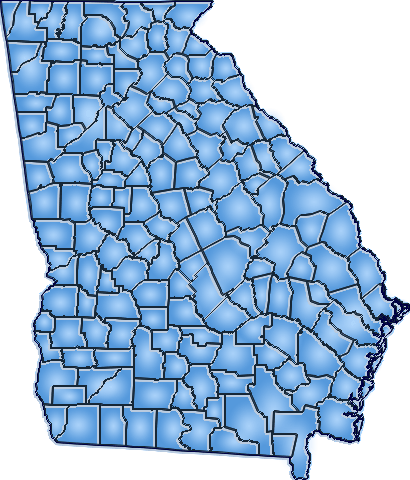Cook County vs. Georgia Comparative Trends Analysis: Gross Domestic Product Growth and Change, 2017-2022 Introduction  Cook County: 2022 GDP = $500,432K 2022 Percent of State = 0.07% Georgia: 2022 GDP = $767,377,565K 2022 Percent of U.S. = 2.98% Nationally, GDP (Gross Domestic Product) is widely regarded as the foremost blue-chip barometer for tracking and calibrating the economic performance of the economy nationwide. Like its closely followed national counterpart, the GDP of Cook County is the most comprehensive measure of output of all goods and services produced by labor and property located within Cook County. It is a market valuation of the goods and services-both private and public-produced within a regional economy. Unlike the widely and frequently reported employment and job numbers that measure labor as one of the units of input into production, GDP is a valuation of the output. Also, while County Personal Income is representative of the "purchasing power" of those that reside within a county, think of Gross Domestic Product as representative of the "producing power" of that county. For a more detailed and technical explanation of Gross Domestic Product (GDP) by County compiled by the Regional Product Branch of Bureau of Economic Analysis please refer to the A Primer on Local Area Gross Domestic Product Methodology article found on the BEA website. BEA: DefinitionGDP by county is the county counterpart of the Nation's gross domestic product (GDP), the Bureau's featured and most comprehensive measure of U.S. economic activity. GDP by county is derived as the sum of the GDP originating in all the industries in a county. The statistics of real GDP by county are prepared in chained (2017) dollars. Real GDP by county is an inflation-adjusted measure of each county's gross product that is based on national prices for the goods and services produced within that county. The statistics of real GDP by county and of quantity indexes with a base year of 2017 were derived by applying national chain-type price indexes to the current-dollar GDP-by-county values for the 64 detailed NAICS-based industries for 1997 forward. The chain-type index formula that is used in the national accounts is then used to calculate the values of total real GDP by county and of real GDP by county at more aggregated industry levels. Real GDP by county may reflect a substantial volume of output that is sold to other counties and regions. To the extent that a county's output is produced and sold in national markets at relatively uniform prices (or sold locally at national prices), real GDP by state captures the differences across states that reflect the relative differences in the mix of goods and services that the counties produce. However, real GDP by county does not capture geographic differences in the prices of goods and services that are produced and sold locally. United States. Bureau of Economic Analysis, Regional Product Division. BEA: Relation of GDP by county to U.S. Gross Domestic Product (GDP)An industry's GDP by county, or its value added, in practice, is calculated as the sum of incomes earned by labor and capital and the costs incurred in the production of goods and services. That is, it includes the wages and salaries that workers earn, the income earned by individual or joint entrepreneurs as well as by corporations, and business taxes such as sales, property, and Federal excise taxes that count as a business expense. GDP is calculated as the sum of what consumers, businesses, and government spend on final goods and services, plus investment and net foreign trade. In theory, incomes earned should equal what is spent, but due to different data sources, income earned, usually referred to as gross domestic income (GDI), does not always equal what is spent (GDP). The difference is referred to as the "statistical discrepancy." Starting with the 2004 comprehensive revision, BEA's annual industry accounts and its GDP-by-county accounts allocate the statistical discrepancy across all private-sector industries. Therefore, the GDP-by-county statistics are now conceptually more similar to the GDP statistics in the national accounts than they had been in the past. U.S. real GDP by county for the advance year, 2012, may differ from the Annual Industry Accounts' GDP by industry and, hence NIPA (National Income and Product Account) GDP, because of different sources and vintages of data used to estimate GDP by state and NIPA GDP. For the revised years of 2009-2011, U.S. GDP by county is nearly identical to GDP by industry except for small differences resulting from the GDP-by-county accounts' exclusion of overseas Federal military and civilian activity (because it cannot be attributed to a particular state). The GDP-by-industry statistics are identical to those from the 2012 annual revision of the NIPAs, released in July 2012. However, because of revisions since July 2012, GDP in the NIPAs may differ from U.S. GDP by county. United States. Bureau of Economic Analysis, Regional Product Division. Cook County Gross Domestic Product, 2018-2022 Current vs. Chained 2017 Dollars (Millions)  Figure 1. Figure 1 depicts Cook County's annual gross domestic product over 2018-2022 in current and constant (chained 2017) dollars. Constant dollar measurements remove the effects of inflation. They allow for comparison of changes in the real total good and services output of Cook County over time. When measured in current dollars, Cook County's GDP increased 27.81%, from $392M in 2018 to $500M in 2022. When measured in constant 2017 dollars to adjust for inflation, it advanced 4.66%, from $382M in 2018 to $400M in 2022. Real Gross Domestic Product, 2017-2022 (Millions)  Figure 2. Figure 2 tracks Cook County's and Georgia's annual real gross domestic product for the period 2017-2022 to illustrate real gross domestic product patterns over time. During this 6-year period, Cook County's real gross domestic product rose from $362M in 2017 to $400M in 2022, for a net gain of $38M, or 10.57%. In comparison, Georgia's real GDP increased from $583,543M in 2017 to $655,827M in 2022, for a net gain of $72,284M, or 12.39%. Real Gross Domestic Product Indices (2017=100): 2017-2022  Figure 3. Figure 3 portrays Cook County's real gross domestic product growth in a broader context by offering direct comparisons across time with Georgia, the United States. The growth indices shown here express each region's real gross domestic product in 2017 as a base figure of 100, and the real gross domestic products in later years as a percentage of the 2017 base figure. This method allows for more direct comparison of differences in real gross domestic product growth between regions that may differ vastly in size. Cook County's overall real GDP growth was 10.57% over 2017-2022 trailed Georgia's increase of 12.39%, and fell below the United States' increase of 11.27%. Gross Domestic Product as a Percent of the Georgia Total: 2017-2022  Figure 4. Another interesting and insightful way of highlighting the gross domestic product growth of Cook County is to trace its individual percentage contributions to Georgia's statewide gross domestic product over time, as shown in Figure 4. A rising share means a region's gross domestic product grew faster, or declined less, than Georgia's gross domestic product, while a declining share shows it grew more slowly. In 2017, Cook County's GDP totaled 0.06% of Georgia's GDP, while in 2022 it comprised 0.07% thereby yielding a +0.00% share-shift.
Cook County Real Gross Domestic Product: Annual Percent Change, 2018-2022  Figure 5. Figure 5 displays the short-run pattern of Cook County's real gross domestic product growth by tracking the year-to-year percent change over 2018-2022. The average annual percent change for the entire 5-year period is also traced on this chart to provide a benchmark for gauging periods of relative high--and relative low--growth against the backdrop of the long-term average. On average, Cook County's real GDP grew at an annual rate of 2.15% over 2018-2022. The county posted its highest growth in 2021 (9.77%) and posted its lowest growth in 2020 (-4.89%). In 2022, Cook County's real GDP grew by 0.22% Cook County Real Gross Domestic Product: Annual Percent Change and Decade Averages Over 2018-2022  Figure 6. Figure 6 again traces the annual percent change in Cook County's real gross domestic product since 2018, but this time they are displayed with the average growth rate for 2020-2022. During the 2020s, Cook County's annual real GDP growth rate averaged 1.70%. Real Gross Domestic Product Growth: Average Annual Percent Change by Decade  Figure 7. Figure 7 compares the decade average growth rates for Cook County noted in the previous graph with the corresponding decade averages for Georgia and the nation. As the chart reveals, Cook County's average annual real gross domestic product growth and fell below Georgia's average over the 3 year period of the current decade, 2020-2022 (1.70% vs. 1.92%). Finally, relative to nationwide real gross domestic product growth trends, Cook County and trailed the nation over 2020-2022 (1.70% vs. 1.84%).
| Analysis Options Menu | |||||||||||||||||||||||||||||||||||||||||||||||||||||||||||||||||||||||||||||||||||||||||||||||||||||||||||||||||||||||||||||||||||||||||||||||||||||||||||||||||||||||||||||||||||||||||||||||||||||||||||||||||||||||||||||||||||||||||

